| Pamantasang Pampamahalaan ng Negros Oriental (Filipino) | |
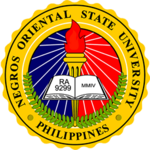 | |
| Former names |
|
|---|---|
| Motto | Culture of Service and Excellence |
| Type | Public state university, research, non-profit, coeducational higher education institution |
| Established | 2004; 21 years ago (2004) (as NORSU) |
| Academic affiliations | AACUP, PASUC |
| President | Noel Marjon E. Yasi, Psy.D. |
| Vice-president | Dr. Merivic G. Catada (VP for Administration & Finance) Dr. Rosemarie T. Pinili (VP for Academic Affairs) Dr. Edwin F. Romano, Jr. (VP for Research, Innovation, Development & Extension) |
| Undergraduates | 23,354 |
| Postgraduates | 770 |
| Doctoral students | 109 |
| Location | Kagawasan Avenue, Dumaguete, Negros Oriental, Philippines 9°18′43″N 123°18′12″E / 9.31197°N 123.30337°E / 9.31197; 123.30337 |
| Campus | Urban Main: I & II (Bajumpandan) Satellite
Extension Pamplona Campus |
| Colors | Blue and White |
| Nickname | Norsunian |
| Mascot | NORSU Tigers |
| Website | www |
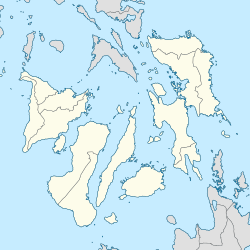  | |
Negros Oriental State University is a public/state nonsectarian higher education institution in Dumaguete, Philippines. It was founded in 2004 by virtue of RA 9299. It is the only state university in the province of Negros Oriental, Philippines. Its Main Campus is located in Dumaguete and has the most number of academic programs and student organizations. It also has 6 satellite campuses all over the province. Formerly Central Visayas Polytechnic College, it was converted into a state university for students from Visayas and Mindanao.
The Main Campus is on Kagawasan Avenue, Dumaguete, beside the provincial capitol building of Negros Oriental.
History
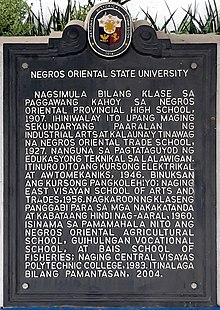
The beginnings of what is now the Negros Oriental State University date back to 1907, from a single woodworking class at what was then the Negros Oriental Provincial School, the forerunner of the present Negros Oriental High School. As more industrial art subjects were added, a separate arts and trade school on the secondary level called the Negros Oriental Trade School, which became the East Visayan School of Arts and Trades in 1956 and the Central Visayas Polytechnic College in 1983. In 2004, it was converted into what is now the Negros Oriental State University.
The Negros Oriental Provincial School
The Negros Oriental Provincial High School was the precursor of what is now the Negros Oriental High School. It opened in Dumaguete on September 1, 1902. The "Provincial School," as it was simply referred to before, arose at the time when the principal stress in the program of public instruction of the American Civil Government in the Philippines was simply the introduction of the most basic academic program at the elementary and secondary levels. It was one of the 23 high schools in the country at that time.
1907 The school was started as a small shop on the intermediate level (fifth grade). It was located on the City Hall ground and was adjunct to the provincial schools which had both intermediate and high school classes. Mr. Leonard Brendenstein, a foreigner, was in charge of the school and woodworking was the only course offered at that time. 1916 Mr. Candido Alcazar became the principal of the school and the only course offered was still woodworking. The sixth and seventh grades were opened and conducted in the same small shop. 1922 Mr. Teodoro Senador Sr. took over as principal with Miss Salud Blanco, Mr. Estanislao Alviola Sr. and Mr. Fermin Canlas as teachers. There were at that time 258 intermediate pupils.
The curriculum offered by the Provincial School included English, reading, grammar, composition, arithmetic, geography, US history, and spelling. There was also a sewing class, which served as prototype of the vocational arts and trades education in the public schools in the province.
The Negros Oriental Trade School (NOTS)
The Negros Oriental Trade School (NOTS) was ordered to be created on December 3, 1927, by virtue of Act No. 3377 of the Philippine Legislature. The school was officially named NEGROS ORIENTAL TRADE SCHOOL (NOTS) and became a separate trade school on the secondary level to stress the promotion of education in trades and industries.
In July 1928, with Mr. Flaviano Santos as Principal, the first year class has 25 students. Though it was already considered as a separate institution, its students, however, continued to take their academic courses in English and Mathematics at the Negros Oriental Provincial High School.
With the growth in size of the Negros Oriental Trade School, it became imperative to have its own campus. Thus on July 26, 1930, Mr. Paul Wittman, the Division Superintendent of Schools for Negros Oriental, petitioned the Governor-General Henry Dwight F. Davis to reserve for the future campus of the Negros Oriental Trade School a piece of property adjoining the Catholic town cemetery, which lay at what was then the outskirts of Dumaguete.
In 1930 Mr. Flaviano Santos continued to be the principal with two sections of the First year and one section of the Second year. Mr. Fermin Canlas taught drawing and Mr. Estanislao Alviola Sr. taught shopwork. Building Construction was introduced with woodworking as a course.
In 1932, NOTS was transferred from its premises at the ground floor of the Municipal Hall to its present campus. That same year, it conferred diplomas on its first 18 graduates. The trade school was transferred to the present site and 18 fourth year students were turned out as first graduates with Julian Abrasado and Sixto Dilicano as valedictorian and salutatorian respectively. Upon the transfer of Mr. Flaviano Santos, Mr. Isabelo Sarmiento assumed office as principal of the school. He served less than a year on account of his transfer to Bohol.
In 1933 Mr. Vicente Enrile took over the principalship of the school for a short time and he was later transferred to Zamboanga Trade School. A permanent L-shaped building costing more than P35,000.00 was constructed from national funds.
From 1934-1941 Mr. Vicente Macairan became the principal. Shop courses were housed in the concrete building and students took their academic subjects at the Negros Oriental High School. Mr. Simplicio Mamicpic headed the academic department. About 1938, Building Construction was offered as a course.
The members of class 1942 of NOTS were never to finish the school year. Like all other schools throughout the country, Negros Oriental Trade School was closed. Some of its male faculty and students rose to join the colors during the World War II.
The Negros Oriental Trade School campus was used by the US Army in 1945 as quarters for Japanese prisoners of war whom they captured. NOTS was then reopened in July 1946.
In 1946 Mr. Francisci Apilado took charge of the school when it reopened. Later Mr. Roberto Angeles became the principal of the school until his transfer to Agusan as Industrial Supervisor. Then Mr. Proceso Gabor became the principal. Electricity and Automechanics were new courses offered. Reparation machines were acquired from Leyte to augment the technical shop equipment.
In 1948 The Related Subjects building was constructed from provincial funds. The academic department was headed by Mr. Esperidion G. Heceta after the liberation. After serving for a year, Mr. Heceta was promoted as principal of Larena Sub-Provincial High School. Mr. Fermin C. Santos took over the headship of the department. In view of the BPS ruling that National (Insular) teachers be placed in the national schools, Mr. Santos was persuaded by the Division Superintendent of Schools to exchange places with Mr. Pedro S. Flores, a National (Insular) teacher of the Negros Oriental High School. Mr. Flores did not stay long in this capacity and Mr. Santos was called back to assume the position of the academic department head.
In 1950 Mr. Marcelo Bonilla headed the school as principal. The Girls Trade semi-permanent building was constructed. Courses for girls were offered for the first time and 24 girls enrolled. The total enrolment was 865 and there were 40 teachers. It became coeducational for the first time.
In 1951 the enrolment soared to 1476 and there were 311 girls and 1165 boys. The faculty and staff totaled 66.
From 1953-1955 under the PHILCUSA-FOA Program, equipment and supplies were given to the school. Some buildings were constructed under the foreign aid program. Equipment and machinery in the Machine Shop, Woodworking, and Sheet Metal were installed. The enrolment of the school further rose to 1943 in the school year 1954-55, and the personnel and the teachers totaled 84. Mr. Teodulfo Despojo was the principal when Mr. Marcelo Bonilla was promoted as Superintendent of Zamboanga School of Arts and Trades.
The East Visayan School of Arts and Trades (EVSAT)
By virtue of Republic Act No. 1579 signed into law on June 16, 1956, the Negros Oriental Trade School became the EAST VISAYAN SCHOOL OF ARTS AND TRADES (EVSAT). Under this new status, EVSAT was headed by a "Superintendent" with a "Principal" assisting him in administering the academic program of the school. The responsibility for the financial support of the school also shifted from the shoulders of the province of Negros Oriental to the national government. The most salient developments in the life of the school at this time included its rise in status to a collegiate level, the diversification of its technical curriculum, and the increase in buildings, machinery, and equipment. The implementation took effect during the school year 1957-58. Mr. Mariano P. Dagdag became the first Superintendent of the School and Mr. Julian A. Corpuz assumed office as principal of the school replacing Mr. Despojo who was transferred Agusan Trade School. Technical Education college courses like machine shop technology, electricity technology, technical drafting, technical building construction and girls trade technical courses were offered.
In 1957, during the administration of Mr. Mariano P. Dagdag, technical education courses on the collegiate level were offered for the first time. These included technical machine shop, technical building construction, technical automotive mechanics, and a number of girl's trades technical courses.
In 1959 Mr. Gregorio P. Espinosa took over as the second superintendent of the school on February 9, succeeding Mr. Dagdag upon his transferred.
In 1960, Evening Opportunity Classes were introduced for the first time, to make trade education accessible to adults and out-of-school youth, and in 1961, three other government schools in Negros Oriental were placed under the administration and supervision of EVSAT. These were the Negros Oriental National Agricultural School (NONAS) in Bayawan, the Guihulngan Vocational School in Guihulngan, and the Bais School of Fisheries in Bais City. To the three was subsequently added the Larena National Vocational School in Larena, Siquijor.
In 1965, EVSAT was authorized by virtue of Republic Act No. 4401 to offer a teacher education program leading to the degree of Bachelor of Science in Industrial Education. This raised EVSAT to the full status of a collegiate institution and pointed in a fresh direction which in time was to bring an entirely new character to the institution.
In 1975, new shop courses in Marine Engineering and Electronics, and Saturday classes in Practical Arts were offered for the first time. EVSAT was also authorized to offer a four-year technical educational program, leading to the degree of Bachelor of Science in Industrial Technology (BSIT), with a major in industrial management and supervision.
The need for candidates for the BSIE degree, major in industrial arts, for laboratory classes to do practice teaching led to MECS authorization in 1976 for EVSAT to open elementary classes at first in Grade V to VI. The full elementary school program began at the start of the new school year in June 1977. In later years, a high school was added as a second laboratory schools.
In 1976, EVSAT's graduate program was inaugurated, starting with the Master of Education degree.
The Central Visayas Polytechnic College
By virtue of Batas Pambansa No. 401 passed on April 14, 1983, and signed into law by President Ferdinand E. Marcos on June 10, 1983, the Central Visayas Polytechnic College came into being. The state college was the result of the merger of three government institutions in Negros Oriental, namely the East Visayan School of Arts and Trades in Dumaguete, the Bais School of Fisheries in Okiot, Bais, and the Guihulngan Vocational School in Guihulngan City, Negros Oriental.
In its educational task, the primary responsibility of the Central Visayas Polytechnic College was "to give professional and technical training in science and technology, advanced specialized instruction in literature, philosophy, arts and sciences, besides providing for the promotion of scientific and technological researchers." The State Collegewas authorized to offer undergraduate courses in liberal arts, engineering, fisheries, agriculture, and short-term vocational courses for the development of middle level skills. It was also authorized to offer graduate courses, after the passage of five years and at the discretion of its Board of Trustees."
On December 11, 1986, Atty. Marcelo C. Jalandoon was formally appointed as the first President of Central Visayas Polytechnic College. President Jalandoon's administration of CVPC encompassed the transition period after Martial Law. Philippine education was faced with the great challenge of responding to the compelling need to stabilize the country's political situation by solidifying its economic foundations and fulfilling popular expectations of a better life, now that freedom has been recovered from the morass of oppressive days.
By 1991, with the solid foundation established by the earnest efforts of CVPC's previous administrators and the unflagging commitment to service of its faculty and staff, Dr. Henry A. Sojor was appointed by Philippine President Corazon C. Aquino on August 1, 1991, as the second President of the College. He took his oath of office five days later before the Secretary of the Department of Education, Culture and Sports, Dr. Isidro Carino.
Negros Oriental State University
Republic Act No. 9299 was signed by President Gloria Macapagal Arroyo on June 25, 2004, and the Central Visayas Polytechnic College (CVPC) was converted into a state university, now known as the Negros Oriental State University (NORSU), integrating therewith the Genaro Goñi Memorial College in the City of Bais, the Siaton Community College in the Municipality of Siaton, and the Mabinay Institute of Technology in the Municipality of Mabinay. And it is officially recognized by the Commission on Higher Education of the Philippines.
Colleges
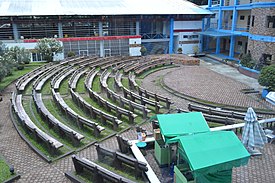
The Dumaguete Campuses of NORSU are composed of nine colleges offering several undergraduate degrees. The Graduate School is located at the Main Campus
| Commission on Higher Education (CHED) Philippines |
| National Centers of Development (COD) |
| Teacher Education |
- College of Agriculture, Forestry and Fisheries
- College of Arts and Sciences
- College of Business Administration
- College of Criminal Justice Education
- College of Teacher Education
- College of Engineering and Architecture
- College of Industrial Technology
- College of Nursing, Pharmacy and Allied Health Sciences
- College of Tourism and Hospitality Management
- College of Law
- Graduate School
Campuses
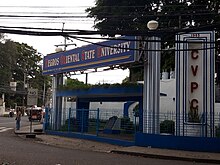
- Main Campus - Kagawasan Ave., Dumaguete
- Bajumpandan Campus - Bajumpandan, Dumaguete
- Bais City Campus 1 (formerly Bais School of Fisheries) - Okiot, Bais
- Bais City Campus 2 (formerly Genaro Goñi Memorial College) - Quezon St., Bais
- Bayawan-Sta. Catalina Campus (formerly Negros Oriental National Agricultural School) - Nat'l Highway, Caranoche, Santa Catalina
- Guihulngan City Campus (formerly Guihulngan Vocational School) - Nat'l Highway, Guihulngan City
- Mabinay Campus (formerly Mabinay Institute of Technology) - Old Namangka, Mabinay
- Siaton Campus (formerly Siaton Community College) - Progresso St., Brgy. III, Siaton
- Pamplona Campus - Pamplona (an extension of Main Campus 2 College of Agriculture, Forestry and Fisheries)
Student life
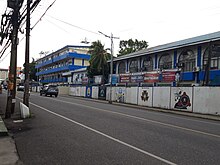
NORSU is known as the school for poor but deserving students. As a state university, NORSU is covered by the free tuition law and thus attracting even more students. NORSU consistently produces many board passers and topnotchers every year.
Enrollment and Population
The university adopted a bi-semestral system wherein students enroll twice each year. Starting S.Y. 2019-2020, NORSU opened the school year on August following the mandate of CHED.
The Dumaguete campuses alone has an average enrollment of about 12,000 students per semester. University-wide enrollment reaches more than 20,000. NORSU doesn't only cater Oriental Negrenses but also students from other provinces notably Siquijor, Negros Occidental, Cebu and Zamboanga del Norte. Some may come from farther provinces, even from Luzon. As of the 1st semester of SY 2017-2018, the population is more or less 12,000 students in the main campuses.
Pylon
Pylon is the Official Yearbook of Negros Oriental State University System. Pylon consist of four (4) Departments: Creative Design & Photography Department, Creative Writing Department, Information, Equipment and Record Management Department and Multimedia & Information System Department.
Student Government
The student government of Negros Oriental State University, named Negros Oriental State University–Federation of Student Governments (NORSU–FSG), is composed of all the student governments of all NORSU system namely:
- a. Student Governments of Dumaguete I
- b. Student Governments of Dumaguete II
- c. Student Governments of Bayawan- Sta. Catalina Campus
- d. Student Governments of Siaton Campus
- e. Student Governments of Bais Campuses
- f. Student Governments of Guihulngan Campus
- g. Student Governments of Mabinay Campus
- h. Student Governments of Pamplona Campus
The NORSUnian Weekly Publication
The NORSUnian is the official Weekly student publication of Negros Oriental State University system. The NORSUnian is one of the three (3) acclaimed student publications in the Philippines which comes out weekly together with the Philippine Collegian of the University of the Philippines in Metro Manila, and the Weekly Sillimanian of Silliman University of Dumaguete.
Hugyawan Festival
A major event of Negros Oriental State University is the Hugyawan Festival, a merrymaking activity highlighting the celebration of NORSU's Foundation Day celebration featuring spectacular parade of colorful costumes, festivities, humorous gimmicks and merrymaking in the streets of Dumaguete from different colleges and satellite campuses of NORSU to showcase the unique way of life of the inhabitants of Negros Oriental, and at the same time, capture the customary response of the Negrenses towards Nature, Fate, and what God has given them, which is thanksgiving through celebration, merrymaking and revelry.
Hugyawan, comes from the Cebuano term “hugyaw” or revelry, is a condensation of the phrase “hugot sa pagbayaw”, which literally translates to sincere tribute or heartfelt offering to God, country and culture and to ourselves. On the cultural front, “hugyaw” means “to make very loud noise using drums and other musical instruments or any other indigenous materials that would make varied types of noise” Making noise is done while dancing, jumping and parading on the streets. It is participated in by all the campuses of the NORSU System.
NORSU-ROTC
Negros Oriental State University—ROTC is the only program offering the Air Force-ROTC, Naval-ROTC and Army-ROTC in the Philippines together with Civic Welfare Training Service (CWTS) & Literacy Training Service (LTS) pursuant to Republic Act 9163 or otherwise known as " The National Service Training Program (NSTP) Act of 2001."
See also
- The NORSUnian
References
- "Negros Oriental State University - Dumaguete - Philippines", Dumaguete Info: The Website of Gentle People. Retrieved May 30, 2013.
- "Negros Oriental State University: Rankings". Study Abroad Aide. Retrieved September 17, 2024.
- "com/ICT-pioneer.html Oriental Negros: Pioneer in Quality Education archive.org/web/20080513165219/http://www.investoriental.com/ICT-pioneer.html Archived 2008-05-13 at the Wayback Machine", Oriental Negros Investment Promotion Center (ONe-IPC). Retrieved May 30, 2013.
- ^ History of Negros Oriental State University, History of Negros Oriental State University edu.ph/history Archived April 29, 2013, at the Wayback Machine, Official Website of Negros Oriental State University. Retrieved May 30, 2013.
- ^ History of Negros Oriental State University, History of Negros Oriental State University (NORSU) System, The Philippine Landmarks Today. Retrieved May 30, 2013.
- ^ "R.A. No. 9299", PhilippineLaw.info: Philippine Legal Materials Database. Retrieved May 30, 2013.
- "Negros Oriental State University". www.geeksforgeeks.org. Retrieved September 17, 2024.
- Finally, NegOr bequeaths P816M NORSU property, The Official Website of the Province of Negros Oriental. Retrieved May 30, 2013.
- "Negros Oriental State University (NORSU)". dumagueteinfo.com. Retrieved September 17, 2024.
- "NORSU to mark 8th Charter day", The Visayan Daily Star. Retrieved May 31, 2013.
- "Negros Oriental State University Ranking & Overview 2024". Uni Rank. Retrieved September 17, 2024.
- "Courses Offered", Negros Oriental State University. Retrieved May 30, 2013.
- "Colleges & Universities", Mabinay.com. Retrieved May 30, 2013.
- "Student Population", Negros Oriental State University Official Website
- "Hugyawan festival to feature ‘carnivals of the world'", Philippine Daily Inquirer, Retrieved June 1, 2013.
- "HUGYAWAN DALANSAYAW", Department of Tourism, Retrieved June 1, 2013.
- "Hugyawan Festival to feature ‘carnivals of the world’", The Visayan Daily Star. Retrieved June 1, 2013.
- "The Most Celebrated Events in Negros Oriental", South Travels. Retrieved May 30, 2013.
- Rachelle Nessia, "Hugyawan festival to feature world's carnivals", MetroPost, Retrieved June 1, 2013.
- "NORSU to Celebrate Hugyawan Festival", Inside Negros. Retrieved June 1, 2013.
- Rachelle Nessia, "Hugyawan Festival to feature ‘carnivals of the world’", Philippine Information Agency. Retrieved June 1, 2013.
- Arellano Law Foundation, "REPUBLIC ACT NO. 9163", The LawPhil Project. Retrieved June 1, 2013.
External links
| NCR | |
|---|---|
| Luzon | |
| Visayas | |
| Mindanao | |
| State Colleges and Universities Athletic Association | |
|---|---|
| NCR | |
| Luzon | |
| Visayas | |
| Mindanao | |